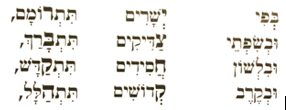By Michael R. Mantell, Ph.D.

If you’re looking for a love story, this week in Toldot, we read a magnificent one, in fact, the first in the Torah. Given this parasha, you might think I’m talking about the love story between parents and children, each in their own unique way. So many have written about the parenting side of this Torah reading, I’m taking a different path. I’m illuminating the love story between the parents in the famous narrative of their relationship with their children.
The first expression of love in the Torah was when we are told that Isaac loved Rebekah, a brave and resourceful young woman. In last week’s parasha, the Radak comments on Isaac “happening to” meet Rebecca, just as Eliezer “happened to” meet Rebecca at the well, that these “meetings seemed to occur by chance,” but, they were the results of Hashem’s Providential Will.
Isaac, we learn this week, “was 40 years old when he took Rebecca, daughter of Bethuel the Aramean from Paddan Aram, sister of Laban the Aramean, as a wife for himself.” Rebecca was the granddaughter of Abraham’s brother.
The Seder Olam tells us that Isaac was 37 years old at the time of the Akeidah, when Rebecca was born. He waited three years until she was physical capable of marriage. Since he was 60 years old when Rebecca gave birth, Rebecca was barren for 20 years. Though Rebecca was the daughter and sister, Rashi tells us, of wicked people, surrounded by wicked people, she overcame this adverse past and did not emulate their evil ways. Her past was simply a reference point, not a residence for her. Clearly, Hashem desires our prayers.
We are told that husband and wife are to “cleave to each other and become one flesh.” This is precisely what Isaac and Rebecca teach us so perfectly, a couple destined to be together. In fact, they even prayed as one. We see this in the gematria of יצחק and רבקה totaling 515, which equals to the gematria of בשר אחד or “one flesh.” Even more, 515 is also the gematria of תפלה.
Rebecca and Isaac today would undoubtedly be considered a “power couple,” leaders in their own way, not simply soul mates but “goal mates,” unified as a couple to build the destiny of our people. Interestingly, although Rebecca was described as “barren,” Isaac prayed for her, the only husband in the Torah to do so. No, not a “perfect” couple, one with communication and trust issues for certain. There was far more right with their love, though, than there was wrong with it.
They are indeed a couple whose love is worth emulating in many ways. Isaac’s prayers are described וַיֶּעְתַּ֨ר יִצְחָ֤ק לַֽיהֹוָה֙ לְנֹ֣כַח אִשְׁתּ֔וֹ “And Isaac prayed to the Lord opposite his wife…” Rashi tells us that “Vaye’ater” is not the usual word for prayer, and is linked with the idea of abundance, suggesting that Isaac prayed profusely for his wife. Additionally, the word “l’nokhakah” is not commonly used to mean for another but is meant to indicate closeness. Isaac prayed close to, opposite, Rebecca, frequently. What does this mean, “opposite his wife”? Our Sages explain that they were in unison, and some say they literally embraced each other face-to-face while praying. Rebecca stood opposite Isaac to be a helper, not an opponent. Despite many differences, these two teach us the importance of sharing the same life’s purpose, principles, and priorities.
Is the Torah telling us that love and prayer are one? Are יצחק and רבקה coming along to show us what proper love and proper prayer are all about? After all, the first time we see the word “love” in the Torah is regarding this couple. Marriage, like prayer, יצחק and רבקה teach us this week, is wisely filled with gratitude, praise, and compliments more than a list of complaints and requests. When we pray, we fill ourselves with a reminder of all the wonders that Hashem has done, and will do, in our lives.
Prayer is less about asking Hashem for things than thanking Him for our lives. The same can be said about wise marriages – we are helpers of each other, not simply givers to each other. Think of prayer and marriage filled with positivity, gratitude, and praise – that’s what יצחק and רבקה reveal to us in Toldot.
There are many lessons to learn from the union of Rebecca and Isaac. Hashem keeps his promises, as Abraham well knew. With emunah we can see how Hashem can use our lives to accomplish His will and purpose for us. And we also see how Hashem brings others into our lives to meet our needs, informing us of the value of leaning on others in healthy ways unconditionally trusting Hashem’s love for us.
The unity of love is seen in the numerical values of the words echad (one) and ahava (love) being the same. Genuine love is a state of being in which two become one flesh, united in their desires and fate. The deeper a couple is aware of their unity, the stronger is their love.
One flesh. Reminds me of the couple who goes to the doctor because the wife injured her foot. The husband accompanies his wife into the exam room and when the doctor asks what brings the wife in, the husband answers, “Doctor, my wife’s foot hurts us.” Us. Unity.
Look in the “Nishmat Kol Chai” prayer we say every Shabbat right before the Shema and Amidah. Find the acrostic that has the names of Isaac and Rebecca that the prayer ends with…it’ll be another reminder of how love and prayer are truly entwined.

With unshakable honesty, as we make Hashem the center of our lives with no prerequisites, unconditionally, as we make our spouses/partners similarly the center of our lives, we become one with Hashem.
Shabbat Shalom…
*
Michael R. Mantell, Ph.D., prepares a weekly D’var Torah for Young Israel of San Diego, where he and his family are members. They are also active members of Congregation Adat Yeshurun. He may be contacted via michael.mantell@sdjewishworld.com